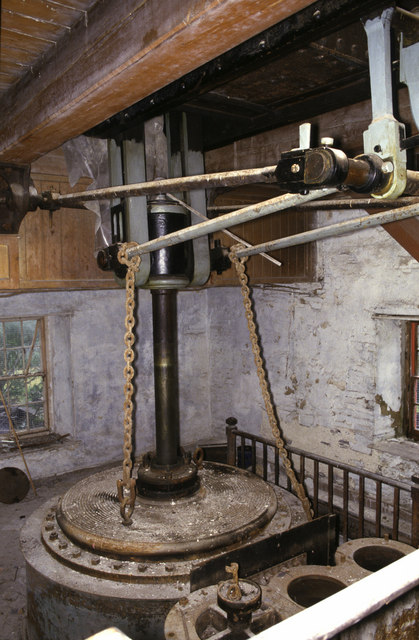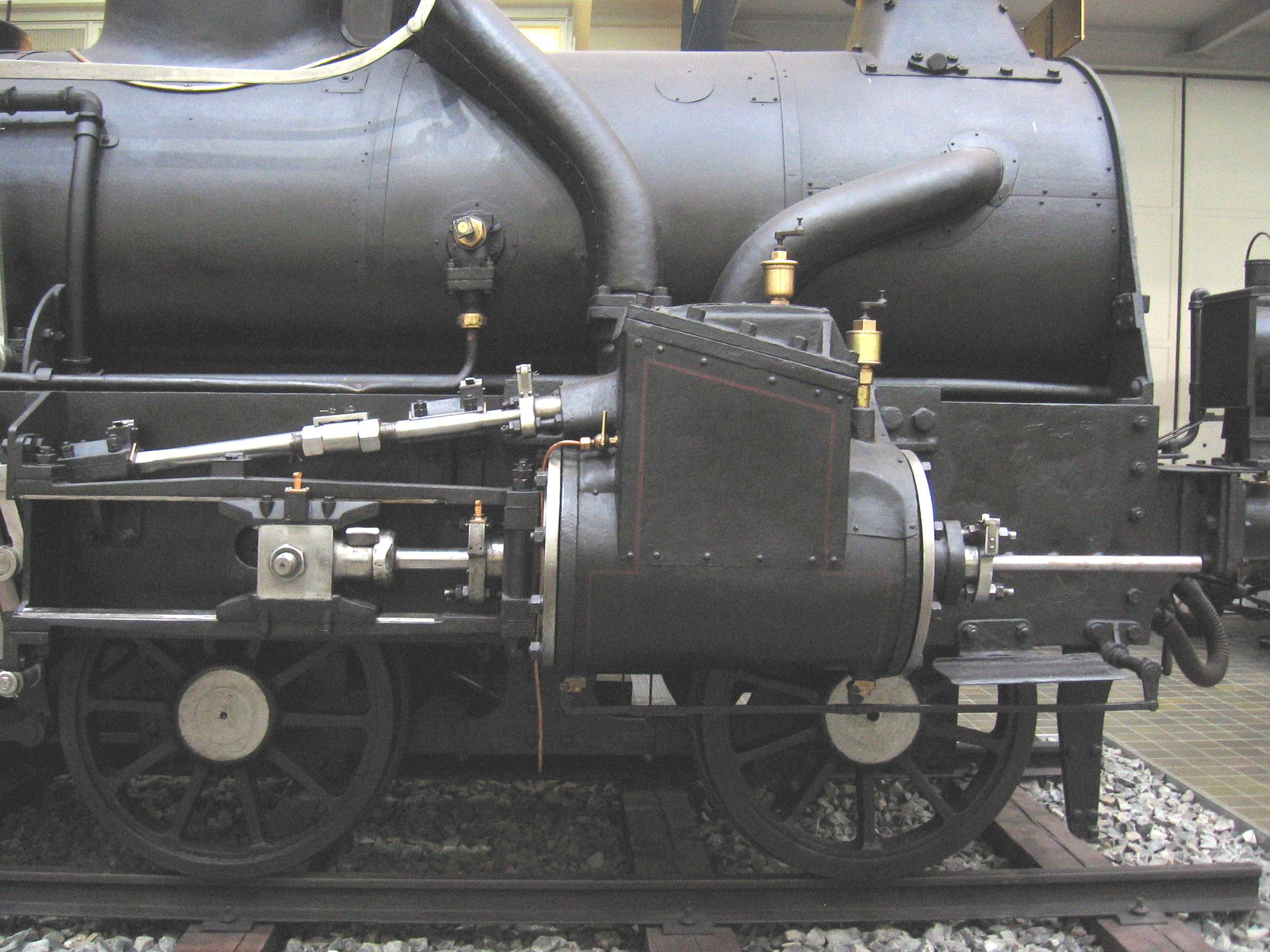piston rod on:
[Wikipedia]
[Google]
[Amazon]
 In a
In a
 The first single-acting
The first single-acting
 Almost all steam locomotives have used a similar design of cylinder, with a crosshead slide mounted adjacent to the cylinder and a short piston rod between them.
Almost all steam locomotives have used a similar design of cylinder, with a crosshead slide mounted adjacent to the cylinder and a short piston rod between them.
 In some cases, tail rods were also used. These were rare in the United Kingdom, but relatively common in Europe, at least for large locomotives.
In some cases, tail rods were also used. These were rare in the United Kingdom, but relatively common in Europe, at least for large locomotives.
 Internal combustion (piston) engines operate at higher speeds than steam engines. They thus benefit from reduced reciprocating mass and from a shorter, stiffer linkage between the piston and the connecting rod. Double-acting engines are also very rare, although these did use piston rods. The high-speed steam engine's lightweight trunk piston was thus soon adopted and remains in service today. Its major changes have been in its sealing rings and the adoption of aluminium alloys to make the pistons lighter.
Some large slow-speed Diesel engines, particularly those for ships, use crossheads and piston rods. Medium- and high-speed diesel engines operate at faster speeds and so use lighter-weight trunk pistons.
Internal combustion (piston) engines operate at higher speeds than steam engines. They thus benefit from reduced reciprocating mass and from a shorter, stiffer linkage between the piston and the connecting rod. Double-acting engines are also very rare, although these did use piston rods. The high-speed steam engine's lightweight trunk piston was thus soon adopted and remains in service today. Its major changes have been in its sealing rings and the adoption of aluminium alloys to make the pistons lighter.
Some large slow-speed Diesel engines, particularly those for ships, use crossheads and piston rods. Medium- and high-speed diesel engines operate at faster speeds and so use lighter-weight trunk pistons.
 In a
In a piston engine
A reciprocating engine, also often known as a piston engine, is typically a heat engine that uses one or more reciprocating pistons to convert high temperature and high pressure into a rotating motion. This article describes the common feat ...
, a piston rod joins a piston
A piston is a component of reciprocating engines, reciprocating pumps, gas compressors, hydraulic cylinders and pneumatic cylinders, among other similar mechanisms. It is the moving component that is contained by a cylinder and is made gas-t ...
to the crosshead
In mechanical engineering, a crosshead is a mechanical joint used as part of the slider-crank linkages of long reciprocating engines (either internal combustion or steam) and reciprocating compressors to eliminate sideways force on the piston ...
and thus to the connecting rod
A connecting rod, also called a 'con rod', is the part of a piston engine which connects the piston to the crankshaft. Together with the crank, the connecting rod converts the reciprocating motion of the piston into the rotation of the crank ...
that drives the crankshaft
A crankshaft is a mechanical component used in a piston engine to convert the reciprocating motion into rotational motion. The crankshaft is a rotating shaft containing one or more crankpins, that are driven by the pistons via the connecti ...
or (for steam locomotive
A steam locomotive is a locomotive that provides the force to move itself and other vehicles by means of the expansion of steam. It is fuelled by burning combustible material (usually coal, oil or, rarely, wood) to heat water in the loco ...
s) the driving wheels.
Internal combustion engine
An internal combustion engine (ICE or IC engine) is a heat engine in which the combustion of a fuel occurs with an oxidizer (usually air) in a combustion chamber that is an integral part of the working fluid flow circuit. In an internal co ...
s, and in particular all current automobile
A car or automobile is a motor vehicle with wheels. Most definitions of ''cars'' say that they run primarily on roads, seat one to eight people, have four wheels, and mainly transport people instead of goods.
The year 1886 is regarded ...
engines, do not generally have piston rods. Instead they use trunk pistons, where the piston and crosshead are combined and so do not need a rod between them. The term ''piston rod'' has been used as a synonym
A synonym is a word, morpheme, or phrase that means exactly or nearly the same as another word, morpheme, or phrase in a given language. For example, in the English language, the words ''begin'', ''start'', ''commence'', and ''initiate'' are al ...
for 'connecting rod' in the context of these engines.
Engines with crosshead
In mechanical engineering, a crosshead is a mechanical joint used as part of the slider-crank linkages of long reciprocating engines (either internal combustion or steam) and reciprocating compressors to eliminate sideways force on the piston ...
s have piston rods. These include most steam locomotive
A steam locomotive is a locomotive that provides the force to move itself and other vehicles by means of the expansion of steam. It is fuelled by burning combustible material (usually coal, oil or, rarely, wood) to heat water in the loco ...
s and some large marine diesel engine
The diesel engine, named after Rudolf Diesel, is an internal combustion engine in which ignition of the fuel is caused by the elevated temperature of the air in the cylinder due to mechanical compression; thus, the diesel engine is a so-cal ...
s.
Steam engines
 The first single-acting
The first single-acting beam engine
A beam engine is a type of steam engine where a pivoted overhead beam is used to apply the force from a vertical piston to a vertical connecting rod. This configuration, with the engine directly driving a pump, was first used by Thomas Newc ...
s, such as Newcomen's, had a single power stroke acting downwards. Rather than a piston rod, they used an iron chain. This could transmit a tensile force, but not a compression force pushing upwards. The piston was sealed in the cylinder around its rim but the top of the cylinder was open. Later, a rudimentary piston rod was used, simply to eliminate the cost of a long forged chain.
Watt
The watt (symbol: W) is the unit of power or radiant flux in the International System of Units (SI), equal to 1 joule per second or 1 kg⋅m2⋅s−3. It is used to quantify the rate of energy transfer. The watt is named after James ...
's development of the steam engine introduced an enclosed upper cylinder. This now required a stuffing box to seal around the piston rod, and for the piston rod to be machined smooth and accurately cylindrical. The engines were still single-acting at this time and the rod was still only acting in tension.
Later developments, also by Watt, produced a double-acting cylinder
In mechanical engineering, the cylinders of reciprocating engines are often classified by whether they are single- or double-acting, depending on how the working fluid acts on the piston.
Single-acting
A single-acting cylinder in a reciproca ...
. The piston rod now had to transmit a force alternately pushing and pulling. The steam engine's general use of an enclosed cylinder, nearly always double-acting, made it dependent on the stuffing box and so the piston rod.
Attachment
Piston rods are usually attached to the crosshead and the piston by a transverse slot and a tapered key or gib. Driving this key sideways tightens the attachment. Using a transverse key allows relatively easy dismantling for maintenance. Some smaller pistons are retained by a threaded piston rod and a large nut, although the crosshead nearly always uses a key. As the precise length of the piston rod is important for timing the engine's valvegear, the attachment tightens the piston down onto a fixed step or location in the piston rod and the length (and valve timing) is not adjustable. This length requires the precision of the manufactured rod but, unlike the rod driving the valves, does not need to be adjusted even more precisely by a fitter during the engine's erection.Tail rods
Early steam engineers were convinced that horizontal cylinders would suffer excessive wear, owing to the weight of the piston riding on the bore of the cylinder. Vertical cylinders remained a favourite for some years. When horizontal cylinders were adopted, one measure used to carry the piston weight was to have an extended or second piston rod on the other side of the piston. This emerged through a second stuffing box and in rare cases (''illus.'') was supported by a second crosshead. Enclosing the entire tail rod in a sealed casing avoided the need for a stuffing box and any leakage of steam. However this also gave a risk that condensed water could accumulate in the casing, leading to hydraulic lock and mechanical damage.Trunk engines
Trunk engine
Trunk may refer to:
Biology
* Trunk (anatomy), synonym for torso
* Trunk (botany), a tree's central superstructure
* Trunk of corpus callosum, in neuroanatomy
* Elephant trunk, the proboscis of an elephant
Computing
* Trunk (software), in re ...
s were compact steam engines, developed for the propulsion of ships. They reduced their overall length by placing the crosshead alongside the piston in the form of a hollow tubular trunk. There was thus no longer any need for a piston rod. The connecting rod and its gudgeon pin
In internal combustion engines, the gudgeon pin (UK, wrist pin or piston pin US) connects the piston to the connecting rod, and provides a bearing for the connecting rod to pivot upon as the piston moves.Nunney, Malcolm James (2007) "The Reciproc ...
were mounted inside this trunk. Trunk engines had extremely large diameter pistons and so the old issue of supporting piston weight and avoiding cylinder wear was again a concern. Trunk engines used a second trunk as a tail rod to support their large pistons.
Single-acting steam engines
Some late steam engines, mostly high-speed steam engines, were also single acting. These also used trunk pistons, but in a new form. These engines were vertical and used a simple piston design, with no separate trunk but using the sides of an elongated piston as the crosshead bearing surface. This trunk piston design would become almost universal for internal combustion engines.Steam locomotives
 Almost all steam locomotives have used a similar design of cylinder, with a crosshead slide mounted adjacent to the cylinder and a short piston rod between them.
Almost all steam locomotives have used a similar design of cylinder, with a crosshead slide mounted adjacent to the cylinder and a short piston rod between them.
 In some cases, tail rods were also used. These were rare in the United Kingdom, but relatively common in Europe, at least for large locomotives.
In some cases, tail rods were also used. These were rare in the United Kingdom, but relatively common in Europe, at least for large locomotives.
Diesel engines
See also
*Steam locomotive components
__NOTOC__
This article is a glossary of the main components found on a typical steam locomotive.
The diagram, which is not to scale, is a composite of various designs in the late steam era. Some components shown are not the same, or are not pre ...
{{Steam engine configurations
Steam locomotive technologies
Locomotive parts
Rod
Engine technology
Linkages (mechanical)